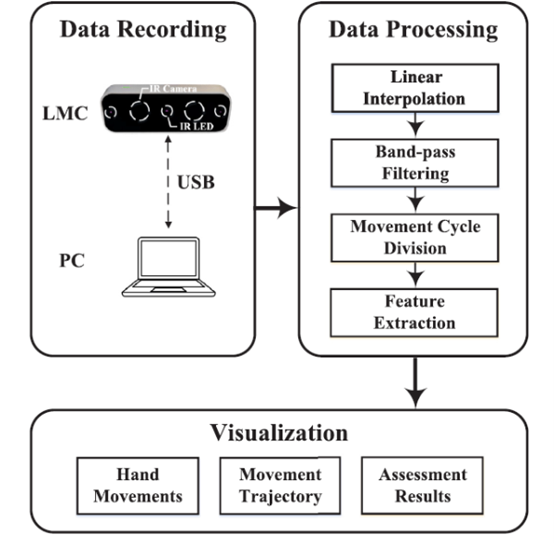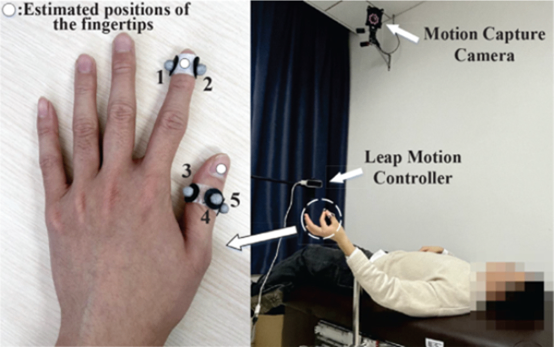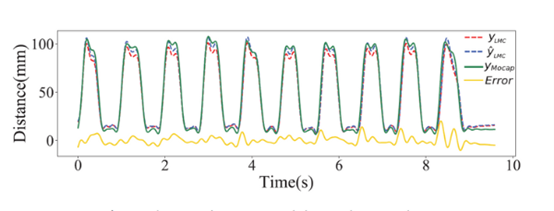A research team led by Professor Han Jianda from Nankai University has proposed an assessment system for Parkinson disease surgery treatment, which can monitor patients hand movements in real-time during surgery, achieve contactless movement feature extraction, and provide data visualization to assist clinical decision-making. The related research paper titled "A non-contact system for intraoperative quantitative assessment of bradykinesia in deep brain stimulation surgery" was published in the international journal Computer Methods and Programs in Biomedicine, which focuses on medical image processing and biomedical informatics.
NOKOV Motion Capture System provides high-precision pose data for measuring hand movements in Parkinson patients, helping to verify the reliability of the Leap Motion Controller (LMC) in the contactless assessment system for measuring hand movement data.
Citation
Ningbo Yu, Yang Yu, Jianeng Lin, Yuchen Yang, Jingchao Wu, Siquan Liang, Jialing Wu, Jianda Han, A non-contact system for intraoperative quantitative assessment of bradykinesia in deep brain stimulation surgery, Computer Methods and Programs in Biomedicine, Volume 225, 2022, 107005, ISSN 0169-2607, https://doi.org/10.1016/j.cmpb.2022.107005.
Research Background
Deep Brain Stimulation (DBS) surgery is an effective method for treating patients with advanced Parkinson disease. Objectively assessing patients movements is crucial for accurately positioning electrodes during surgery. However, existing assessment systems have issues such as subjective differences and interfering with patients voluntary movements. The research team designed an objective quantitative assessment system, which is also a contactless monitoring and evaluation system, solving the problem of wearable devices interfering with patients voluntary movements.
System Design
The quantitative assessment system uses the Leap Motion Controller (LMC) optical sensor, which is small in size and can measure patients hand movements without contact. The LMC software can obtain the direction and 3D coordinates of 27 hand parts with sub-millimeter precision and high sampling frequency. At the same time, a graphical user interface (GUI) is created using the LMCs software development toolkit.
When the system is in operation, the LMC detects the patients hand movements and returns the data frame by frame to the GUI. The GUI interface can display the hand model and trajectory in real-time, automatically save the data, and perform quantitative analysis.

Block diagram of the designed assessment system
Experimental Verification
The reliability of the LMC data was verified using NOKOV Motion Capture System, with healthy individuals as subjects in the experiment. The motion capture system in the experiment contains 8 cameras, which can detect the markers from different angles.

Technical validation with a motion capture system
The results showed that the average Pearson correlation coefficient between the corrected LMC data and NOKOV Motion Capture System data reached 0.986, with an average amplitude difference of 2.11 mm. Moreover, there were no significant differences in the calculation results of all movement features, indicating that the LMC systems measurement and feature extraction data are accurate and reliable.

The LMC data, corrected data and Mocap data
The assessment system was clinically tested on 20 Parkinsons patients undergoing deep brain stimulation surgery, confirming the feasibility of the developed system in intraoperative assessment and its reliable performance. The system is expected to become an objective intraoperative assessment, analysis, and visualization tool for treating Parkinsons disease with deep brain stimulation surgery.
Clinical trial of the contactless quantitative assessment system
NOKOV Motion Capture System, serving as the gold standard, provided high-precision hand movement data for this experiment, helping to verify the reliability of the data from the contactless assessment system in the experiment.